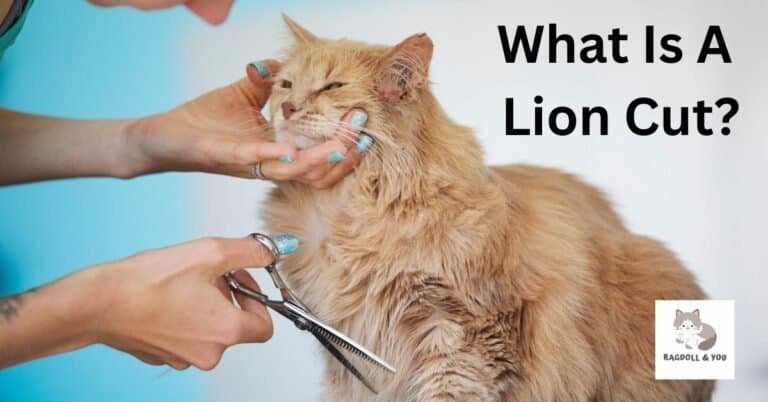How Long Does It Take For Cat Hair To Grow Back?
After shaving your cat for surgery, mat removal or just regular grooming, you may wonder how long it takes for their fur to regrow. While short-haired cats may recover their coat in 2-3 months, long-haired cats can take 3-6 months to regain length. But there’s no definitive timeline – factors like breed, genetics and health impact regrowth speed. An individual cat’s hair growth cycle is key.
Key Takeaways
- Cat hair starts growing back immediately after it falls out.
- Short-haired breeds take about 4 to 6 months for fur to fully regrow.
- Long-haired cats may take 3-6 months.
- Genetics and overall health affect the hair regrowth speed in cats.
- A healthy diet, Regular grooming, exercise, a stress-free environment, and routine vet visits are essential for fast cat hair growth.
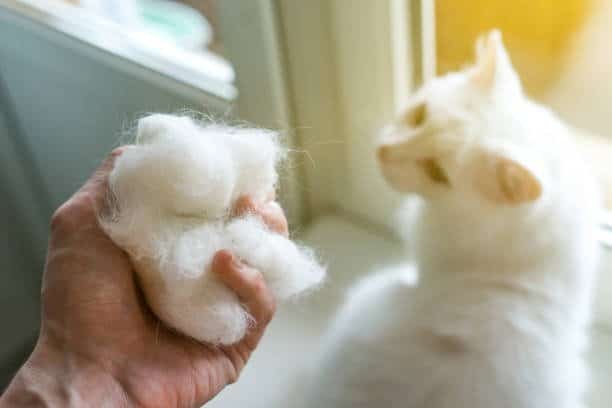
Why Would Anyone Need to Shave a Cat?
There are several reasons why people may shave their cats. Dealing with mats, preparing for surgery, grooming, or addressing a medical condition are some.
1. Mats
Cat hair can get tangled into mats. This happens when the cat’s fur curls up and knots together. It is hard for a cat to groom itself and remove these mats.
They can cause pain and discomfort for your pet. The best choice might be to shave off the matted fur. This lets the damaged skin breathe and keeps your cat clean and healthy.
Regular brushing is key after shaving as it stops tangles from forming again.
2. Surgery
Cats might need a shave before surgery. This keeps the area clean and helps the vet do their job. If your cat has gone through this, you may see short hair starting to grow in a couple of weeks.
It could take up to six months for the fur to return. Shaving might be needed sometimes, but it won’t hurt your pet’s pride too much!
Hair grows back faster in cats with short hair than those long after medical procedures like surgery.
3. Grooming Purposes
Some cat owners groom their cats for a clean look. Pet salons can trim or shave your cat’s hair in style! This is especially true for long-haired breeds. A nice trim can stop the fur from getting dirty too fast.
But, it is always best to keep the cut short and not against the sensitive skin. This way, your cat can stay warm in cold temperatures. It also keeps away skin irritation that may come with close shaving.
4. Health Condition
If hair in cats is not growing back as expected, it could be due to various health conditions, including hormonal imbalance.
The biggest factors affecting hair growth in cats include fur shedding, dermatophytosis (ringworm), external parasites, scabies, allergies, stress, and autoimmune diseases.
Address these underlying health issues to promote healthy hair regrowth in your cat. Consult a veterinarian if you notice abnormalities or concerns about your cat’s slow hair growth.
How Long Will It Take for Cat Hair to Grow Back?
Cats hair will start to grow back immediately after it falls out. The length of time it takes for cat hair to fully regrow depends on the type of cat and the length of its fur.
Short-haired breeds generally take about 4 to 6 months for their fur to grow back completely. Long-haired cats usually have to wait 3 to 6 months for their fur to fully regrow.
Genetics and overall health can also affect how a cat’s body hair grows back. These are general timelines, each cat may experience a different rate of hair regrowth.
Are There Ways to Encourage Faster Hair Growth Rates?
You can encourage faster cat hair growth using the following tips.
Provide a nutritious diet, regular grooming, exercise for better circulation, creating a stress-free environment, and consult with your veterinarian.
Provide a Nutritious Diet
A healthy and balanced diet is crucial for promoting hair growth in cats. To ensure your cat’s fur grows back efficiently, provide them with a decent diet.
Feed them food rich in high-quality proteins, essential vitamins, and doses of minerals. These vital maintain healthy skin and support the growth of strong and shiny fur.
A diet rich in healthy fats promotes hair growth. If you notice any issues with your cat’s fur or are experiencing hair loss, consult a veterinarian for dietary recommendations.
A healthy diet maintains your cat’s overall well-being and ensures their fur grows back properly.
Regular Grooming
Regular grooming is essential for promoting faster hair growth in cats. Grooming our cats regularly helps stimulate blood circulation and distribute natural oils throughout their luxurious coat.
Regular grooming prevents mats and tangles from forming. They can lead to hair loss in cats if left untreated.
Gently brush your cat’s fur with a cat-specific brush or comb. It will remove loose hair and ensure the new ones have space to grow.
Be gentle and patient during grooming sessions to keep your cat comfortable and happy. With consistent grooming, you will notice your furry friend’s hair growing back beautifully in no time!
Exercise for Better Circulation
Regular exercise promotes healthy cat hair growth. Just like in humans, exercise helps improve blood flow throughout the body, including the scalp.
When each body hair follicle receives a good distribution of nutrients and oxygen, it supports faster stages of growth.
Cardiovascular exercises at least thrice a week stimulate blood flow to the scalp. Exercise can also reduce huge amounts of stress, another critical factor leading to hair thinning.
A Stress-Free Environment
Creating a stress-free environment for your cat promotes faster hair growth rates. Environment stress can cause cats to excessively groom or even pull out their hair. It leads to bald spots and a thinning inch of fur.
A calm and peaceful atmosphere prevents these issues and supports healthy hair growth. Cats are sensitive to their surroundings, so maintain a clean and hygienic living space.
It should be free from loud noises, conflicts with other animals, and any potential sources of chronic stress. Remember, a relaxed cat is more likely to have good coat health!
Consult with Your Veterinarian
Veterinarians can guide the best ways to promote cat hair growth and address any underlying conditions affecting it.
Your vet may recommend dietary changes, grooming techniques, or specific supplements to encourage healthy growth. They have the knowledge and experience to provide a proper diagnosis for your cat’s needs.
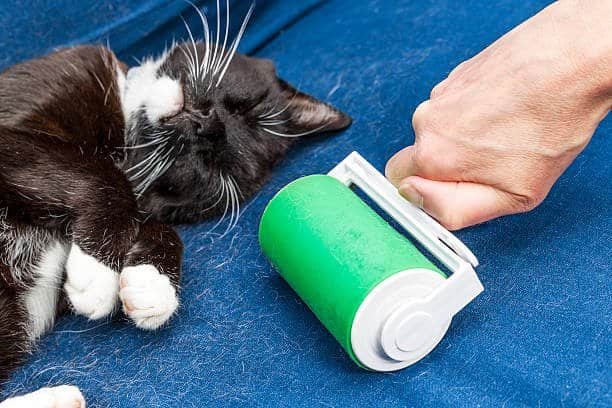
How Long Does Shorthair Cats’ Fur Take To Grow Back After Surgery?
After shaving, it takes approximately two weeks for shorthair cats’ fur to start growing back. Within one month, you won’t be able to see any more shaved skin.
2 Weeks Post-Shave; New Hair Growth Can Be Seen
After shaving a cat, you’ll see new hair growth within 2-3 weeks. The cat hair regeneration begins immediately after shaving, and you should notice some progress by this point.
It may take up to eight weeks for the cat’s fur to fully grow back for short-haired cats. There might be limited shedding as the new hair comes in during this time.
If your cat’s hair is not growing back or if you have concerns, consult with a veterinarian for further evaluation and treatment options.
1 Month Post-Shave; You Will See No More Skin
After one month of shaving your cat, you will notice its delicate skin is no longer visible. The fur will start to grow back, covering the previously exposed areas.
At this stage, your cat’s coat of hair may still be shorter or slightly different in texture than before the shave. There will be a noticeable improvement.
Patience is key. It can take several months for the hair to fully regain its original length and appearance after being shaved.
3 Months Post-Shave; You Can’t Tell Where The Cat Was Shaved
After three months of shaving, you won’t see where the cat was shaved.
By this time, the hair will have fully grown and blended with the rest of the coat. It’s remarkable how quickly cats’ fur can regrow!
6 Months Post-Shave, The Shedding Cycle Will Begin Again
After about 6 months post-shave, your cat’s shedding cycle will start again. The newly grown hair will begin to fall out naturally as part of their normal shedding process.
This shedding is a natural and healthy occurrence for cats, so there’s no need to be alarmed. Continue regular grooming sessions to manage the fur and keep your cat comfortable.
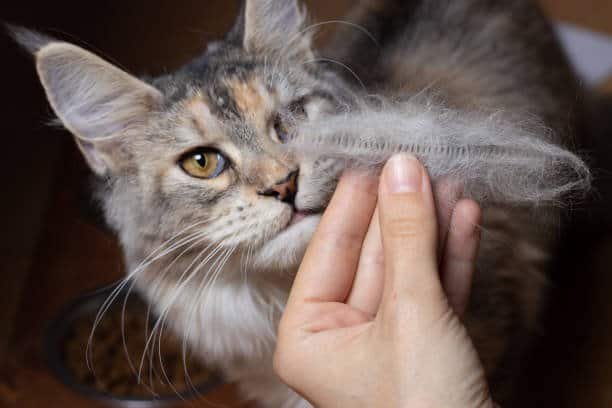
How Long Does Longhair Cats’ Fur Take To Grow Back After Surgery?
2 Weeks Post-Shave; The 5 O’clock Shadow
Two weeks after shaving a long-haired cat, you may notice a “5 o’clock shadow” starting to appear. This means that the new hair growth is just beginning.
You can see some stubble or short hairs on the cat’s body. It takes time for the fur to regrow fully.
At this stage, you will still see shorter hair than before. But don’t worry, as the weeks go by, you’ll see more significant progress in the cat’s fur growing back.
1 Month Post-Shave; Small Amount Of Blending
After one month of post-shaving, you will notice a small amount of blending in the cat’s fur. The hair will start to grow back, but it may not be fully regrown yet.
There might still be some areas where the shaved hair is noticeable. Overall, there will be progress towards full hair regrowth.
Continue providing proper care and grooming during this time to support healthy hair growth for your cat.
3 Months Post-Shave; Part Way To Full Hair Regrowth
Your cat’s hair grows back about three months after shaving. It may not fully regrown yet, but it’s coming!
The fur will be longer and more noticeable compared to the initial shave. Give it more time, and your cat will have their full coat back.
6 Months Post-Shave; Almost To Full Regrowth With Limited Shedding
A longhaired cat’s fur takes about six months to grow back fully after shaving. At this point, the regrowth is almost complete, and shedding is limited.
This means your cat’s coat of fur will return to its original length and thickness with minimal hair loss. It can be exciting to see your furry friend regain their beautiful fur!
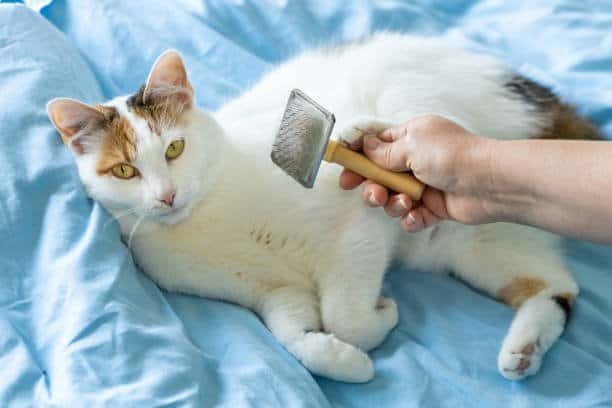
Why Is My Cat’s Hair Not Growing Back?
There are several reasons why your cat’s hair may not be growing back. It includes shedding, dermatophytosis, external parasites, scabies, allergies, stress, and autoimmune diseases.
Fur Shedding
Fur shedding is a common reason a cat’s hair may not grow back. Shedding is a natural process for cats. They typically shed their old fur to make way for new growth.
If your cat isn’t experiencing normal shedding or if there are bald patches, it could indicate an underlying issue. Identify and address the cause of the shedding to promote healthy hair growth.
Dermatophytosis (Ringworm)
Dermatophytosis, or ringworm, is a fungal infection that can affect cats. This common skin condition causes hair loss, redness, and skin scrapings in cats.
Ringworm treatment typically lasts at least six weeks but may take longer for complete healing. During treatment, the cat should be monitored to ensure that new areas of hair loss do not appear.
The crusty appearance of the skin health improves within one to two weeks. Fungal cultures diagnose ringworm in cats, with most cats showing positive culture results within 10 days.
External Parasites
External parasites, like fleas, ticks, and mites, can prevent a cat’s hair from growing back. These pesky bugs can irritate the sensitive skin and cause itching and scratching, leading to hair loss.
They can even transmit skin diseases that affect the fur. Regularly use flea and tick preventives recommended by your veterinarian to encourage hair growth and combat external parasites.
These treatments will protect your cat from infestations and allow their hair to regrow properly.
Scabies
Scabies, or notoedric mange, is a contagious condition in cats caused by tiny parasites called mites. It can result in crusts, scales, abundant mites, and hair loss.
Cats with scabies may experience itching, skin flaking, hair loss, and inflammation. If your cat has scabies, their hair generally takes 1-3 months to grow back fully.
Treatment for scabies usually involves alternative medications prescribed by a veterinarian to eliminate the mites and promote healing.
Allergies
Allergies in cats can lead to hair loss. Some common allergens include flea bite, food allergies, or environmental factors like pollen or dust mites.
When a cat has an allergic reaction, it can cause itching and inflammation. This leads to excessive grooming and, ultimately, the loss of fur.
The recovery time for hair regrowth after allergies varies depending on the underlying cause and severity. It can take several weeks to months for a cat’s hair to grow.
During this time, bald patches may be visible until new hair grows in those areas again.
Stress
Stress can delay the growth of your cat’s fur. When cats are stressed, it can disrupt their normal grooming routine and even lead to excessive hair loss.
It may take longer for their hair to grow back if they are experiencing stress.
Create a stress-free environment for your cat. Provide plenty of mental stimulation, a safe space to retreat to, and regular playtime.
If your cat is experiencing prolonged or severe stress, consult your veterinarian.
Autoimmune Diseases
Autoimmune diseases, like hypothyroidism, cause a reduction in hair follicles and hinder a cat’s hair from growing back. These diseases can occur suddenly without any known cause.
Drugs or chronic skin conditions may trigger them. Cats with autoimmune disorders may experience alopecia hair loss and other symptoms like itchy skin, rashes, sores, and dead skin.
Recognize these signs and seek adequate care to properly diagnose and manage the condition.
The life expectancy of a cat with an autoimmune disease varies based on the specific illness and individual circumstances.

How To Make Your Cat’s Hair Grow Faster?
1. Switch To A Coat-Friendly Diet
To promote faster hair growth rates in cats, switch to a coat-friendly diet. Provide them with high-quality cat food rich in essential nutrients like Omega fatty acids and biotin.
These additional nutrients improve the health of their skin and fur, leading to faster hair growth rates. Some cat foods are specifically formulated to promote enhanced coat health.
After consulting with your veterinarian, you can add supplements like fish oil or a combination of omega 3 fatty acids. By nourishing your cat from within, you can encourage hair growth.
2. Brush Regularly
Regular brushing is essential for promoting healthy hair growth in cats. You can remove dead hair and prevent mats from forming by brushing your cat regularly.
This allows for better circulation, stimulating the hair follicles and encouraging new hair growth. Regular brushing distributes natural oils throughout the coat. It results in a shiny and healthy coat appearance.
3. Eliminate Stressors
Stress can be harmful to cats and contribute to hair loss. Create a stress-free environment to help your cat’s hair grow back faster.
Provide a calm and quiet space to relax, avoid sudden changes or disruptions in their routine, and give them plenty of attention.
Do you notice any signs of stress or anxiety in your cat, like excessive grooming or hiding behavior? In that case, consult with your veterinarian for further guidance.
A peaceful environment is key to promoting healthy hair growth in cats.
4. Use Flea And Tick Preventives
Ticks and fleas can be a real nuisance for cats. They can lead to the slow growth of cat hair. Protecting your furry friend using flea and tick preventives is important.
These preventives come in various forms, like spot-on treatments, collars, and oral medications. They work by killing or repelling ticks and fleas before they can latch onto your cat’s fur.
Keeping these pesky parasites at bay promotes healthy hair growth in your cat.
5. Consider Supplements
Supplements can help cats grow their hair back faster. These supplements promote natural sebum production from the skin, which helps in hair growth.
The growth rate of cat hair may vary between cats. Supplements have been found to speed up the process. This especially benefits long-haired cats who take longer to regain a healthy coat.
When choosing a supplement, consider the thickness and length of your cat’s fur.
6. Control The Room Temperature
Controlling the room’s temperature promotes faster hair growth rates in cats. Cats are sensitive to extreme temperatures. If they are too hot or cold, it affects their overall health and hair growth.
Ensure that the room where your cat spends most of its time is comfortable. The ideal temperature is 68-78 degrees Fahrenheit (20-25 degrees Celsius).
7. Seek Veterinary Help
If your cat’s hair is not growing back as it should, seek veterinary help. Veterinarians can guide the best methods to promote hair regrowth in cats.
They recommend treatments or medications to aid this process and identify underlying health issues. Regular vet check-ups monitor the progress of your cat’s hair regrowth.

FAQ
Is It A Good Idea To Shave Cats In The Summer?
Shaving cats in the summer may seem like a way to help them stay cool. But it’s not a good idea. The belief that shaving cats keeps them cool is a misconception.
Cats’ fur acts as insulation and protects their skin from the sun. Shaving can leave them vulnerable to sunburn, insect bites, and other skin issues.
Shaving your cat does not eliminate the need for regular brushing to prevent matting. Instead of shaving your cat in the summer, provide plenty of fresh water and a cool environment.
Does Cat’s Fur Grow Longer As They Age?
As cats age, their fur may grow longer. Some cats experience an increase in hair length as they get older. The growth rate of cat hair can vary among individual cats.
Persian breed of cats, known for their long hair, may take longer to regrow their fur than other breeds. Not all cats have longer fur growth with age. It depends on genetics and overall health.
Should I Give My Cat A Lion Cut?
Giving your cat a specialized lion cut can have some benefits, like removing matted fur and reducing shedding. Remember, the fur may take up to three to six months to fully grow back.
Consider whether you’re comfortable with this timeframe before making a decision.
How Do I Fix My Cat’s Bald Spot?
If your cat has a bald spot, the first step is identifying the underlying cause. Common causes include allergies, parasites, stress, or over-grooming.
If it’s due to fleas or mites, you can use appropriate treatments to eliminate them. If stress is the issue, creating a calm and relaxing environment for your cat may help.
Consult with a veterinarian for the best guidance and treatment options. Be patient, as hair regrowth takes time and varies depending on individual cats.
Why Is My Cat’s Hair Not Growing Back?:
If your cat’s hair is not growing back, there could be several reasons. One common reason is fur shedding, a normal process for cats.
If the shedding seems excessive or there are bald patches, it may indicate an underlying health issue. Ringworm, external parasites, scabies, allergies, stress, or autoimmune diseases are few.
How Long For Cat Hair To Grow Back After Spaying?
After a cat is spayed, their hair usually takes 2 to 6 months to grow back. The exact time can vary depending on the individual cat.
Shorter-haired cats regrow their fur faster than longer-haired cats.
Is Hair Loss From Ringworm Permanent?
Hair loss from ringworm can be a long-term issue if not treated properly. These fungal spores can cause scarring and permanent hair loss if there is an overly vigorous reaction to the fungus.
Seek veterinary consultation for proper treatment. There are home remedies available, but they may not be sufficient.
Quarantining the affected cat prevents the spread of the skin infection to other animals or humans.
Will Cat’s Hair Grow Back After Fleas?
After treating your cat for fleas, their hair will usually grow back. Cat bald spots typically regrow once the underlying cause is addressed. The time it takes for the hair to grow back can vary.
It may take a few weeks for shorthaired cats to regrow fully. Longhaired cats may take around 4 to 6 months for their fur to grow.







